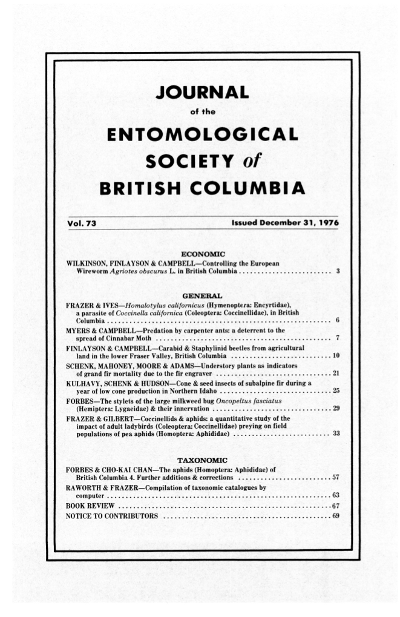Cone and seed insects of subalpine fir during a year of low cone production in northern Idaho
Keywords:
subalpine fir, <i>Abies lasiocarpa</i>, coneworm, <i>Dioryctria abietivorella</i>, midge, <i>Dasineura</i>, Diptera, <i>Hylemya abietis</i>, <i>Earoymia</i>, <i>Asynapta keeni</i>, Chalcidae, <i>Megastigmus lasiocarpae</i>Abstract
Cone and seed insects destroyed 29 percent of the seed crop of subalpine fir (<i>Abies lasiocarpa</i>) in the Freezeout Mountain area of northern Idaho in 1972 during a year of low cone production. Larvae of a coneworm, <i>Dioryctria abietivorella</i> destroyed 12 percent of the seed crop, accounting for 42 percent of the total insect damage. A newly discovered midge pest, a species of <i>Dasineura</i>, destroyed 11 percent of the seed crop, amounting to 40 percent of the total insect damage. The dipterans, <i>Hylemya abietis</i>, <i>Earoymia</i> sp., and <i>Asynapta keeni</i>, and the chalcid wasp, <i>Megastigmus lasiocarpae</i>, together destroyed 4 percent of the seed crop. Unknown causes accounted for 1.5 percent of the total seed destruction. X-ray was used to estimate seed lost to <i>M. lasiocarpae</i> and <i>Dasineura</i> sp. Regression equations are given relating cone length (mm), and the seeds on the axial surface, to total seeds. Sound and damaged seeds on the axial surface were highly correlated with the totals of sound and damaged seeds, respectively, in the cone.References
Bramlett, D.L. and J.G. Hutchinson. 1964. Estimating sound seed per cone in shortleaf pine. U.S. Dept. Agr. Forest Serv. Res. Note SE-18. 2 pp.
Daubenmire, R. and J.B. Daubenmire. 1968. Forest vegetation of eastern Washington and northern Idaho. Wash. State Univ. Agr. Exp. Sta. Tech. Bull. No. 60. 104 pp.
Fedde, G.F. 1973. Impact of the balsam woolly aphid (Homoptera: Phylloxeridae) on cones and seed produced by infested Fraser fir. Can. Entomol. 105:673-680.
Hedlin, A.F. 1974. Cone and seed insects of British Columbia. Pacific Forest Res. Cen., Victoria. Brit. Col. 63 pp.
Keen, F.P. 1958. Cone and seed insects of western forest trees. U.S. Dept. Agr. Misc. Bull. No. 1169. 168 pp.
Kulhavy, D.L. 1974. Cone and seed insects of grand and subalpine firs in northern Idaho. College of Forestry, Wildlife and Range Sciences. M.S. thesis. University of Idaho. 79 pp.
Kulhavy, D.L, J.W. Dale, and J.A. Schenk. 1975. A checklist of the cone and seed insects of Idaho. Forest. Wildlife and Range Experiment Station. Univ. of Idaho, Info. Ser. No.6. 28 pp.
Kulhavy, D.L. and J.A. Schenk. 1976. An evaluation of damage by cone and seed insects of grand fir in northern Idaho. Univ. of Idaho, Dept. of Entomol. 50th Anniversary Pub. (in press).
McAlpine, J.F. 1956. Cone-infesting Lonchaeids of the genus Earomyia Zett, with descriptions of five new species from western North America (Diptera: Lonchaeidae). Can. Entomol. 88:178-196.
McLemore, B.F. 1961. Estimating pine seed yields. U.S. Dept. Agr. Forest Serv. SE Exp. Sta. Rep. No. 134. 2 pp.
Moyer, M.M. and D.L. Parker. 1973. A revised list of seed and cone insects collected from native conifers in the Intermountain Region. Branch of Forest Insect and Disease Prevention and Control. U.S. Dept. Agr. Forest Serv., Ogden, Utah. 15 pp.
Speers, C.F. 1968. Insect infestation distorts Fraser Fir seed tests. U.S. Dept. Agr. Forest Serv. Tree Planters' Notes 18:19-21.
U.S. Dept. Agr. 1965. Silvics of forest trees of the United States. U.S. Dept. Agr . Forest Serv. Handbook No. 271. 762 pp.
U.S. Dept. Agr. 1974. Seeds of woody plants in the United States. U.S. Dept. Agr. Handbook No. 450. 883 pp.
Winjum, J.K. and N.E. Johnson. 1960. A modified knife-cone cutter for Douglas-fir seed studies. J. Forest. 58:487-488.
Downloads
Published
Issue
Section
License
Authors who publish with the Journal of the Entomological Society of British Columbia agree to the following terms:
-Authors retain copyright and grant the journal right of first publication with the work simultaneously licensed under a Creative Commons Attribution License that allows others to share the work with an acknowledgement of the work's authorship and initial publication in this journal.
-Authors are able to enter into separate, additional contractual arrangements for the non-exclusive distribution of the journal's published version of the work (e.g., post it to an institutional repository or publish it in a book), with an acknowledgement of its initial publication in this journal.
-Authors are permitted and encouraged to post their work online (e.g., in institutional repositories or on their website) prior to and during the submission process, as it can lead to productive exchanges, as well as earlier and greater citation of published work (See The Effect of Open Access).


